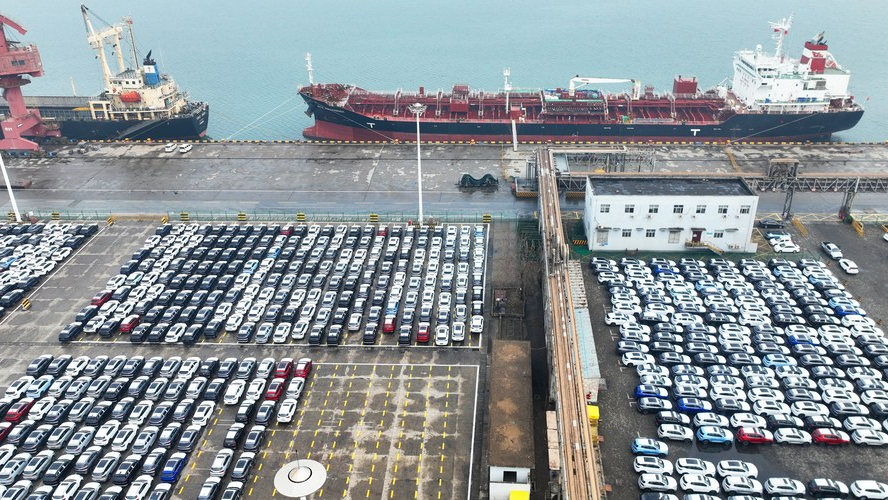
This aerial photo shows vehicles to be exported at a port in Lianyungang, east China's Jiangsu Province, January 13, 2023. /Xinhua
This aerial photo shows vehicles to be exported at a port in Lianyungang, east China's Jiangsu Province, January 13, 2023. /Xinhua
Editor's note: Azhar Azam, a special commentator for CGTN, works in a private organization as a market and business analyst and writes on geopolitical issues and regional conflicts. The article reflects the author's opinions and not necessarily the views of CGTN.
In the first seven months of 2023, China's foreign trade increased 0.4 percent to more than 23.5 trillion Chinese yuan (about $3.3 trillion). Trade with the Association of Southeast Asian Nations, Central Asia, Latin America, Africa and countries along the Belt and Road posted a robust growth.
The data is well in line with the expectations forecast by the Chinese government and global financial institutions amid a flagging global demand. Linking the resilience of Asia-Pacific with Beijing, the International Monetary Fund (IMF) in its most recent economic outlook in May anticipated a "fresh impetus" coming from the reopening of China and its economic expansion of 5.2 percent in 2023, seeing the surging consumption in the country boosting the world's most dynamic region's growth despite "weaker demand" from the rest of the world.
The World Bank in its June China Economic Update also stated a soft external demand with weak global growth could impact exports, yet it projected the Chinese gross domestic product (GDP) to be 5.6 percent in 2023, led by a rebound in consumer demand. All these trade numbers and projections reveal the Chinese economy has overall maintained stability and is on track to achieve its target.
In July, exports and imports fell 8.3 percent to around 3.5 trillion yuan ($490 billion). External factors such as declining consumer spending in developed countries, potential recession, inflation and falling commodity prices contributed to the sporadic fall; or else Chinese exports have diversified to other markets with areas like mechanical and electrical products, especially exports of new energy vehicles, proving a bright spot.
China's private sector – which has been reviving up since the global financial crisis, becoming one of the important factors of China's economic growth – is one of the major features of the country's progress. According to the latest statistics, private enterprises in China at the close of the first half of 2023 continue to be a key driver of the country's foreign trade, making up 52.7 percent of the Chinese value of foreign trade.

The photo shows a night fair in Jinghong City of Xishuangbanna Dai Autonomous Prefecture, southwest China's Yunnan Province, February 12, 2023. /Xinhua
The photo shows a night fair in Jinghong City of Xishuangbanna Dai Autonomous Prefecture, southwest China's Yunnan Province, February 12, 2023. /Xinhua
Their import and export volume soared 8.9 percent to 10.6 trillion yuan ($1.47 trillion), including the export of high and new technology goods of more than 1.2 trillion yuan ($170 billion) that saw a surge of 5.4 percent. The privately-owned firms also provided a fillip to the national economy, technological development and job creation as they accounted for 90 percent of all enterprises as well as contributing to 50 percent of the tax revenue, 60 percent of the gross domestic product (GDP), 70 percent of the tech innovation, 80 percent of the urban employment and 90 percent of new jobs.
In a nutshell, the private sector sustained its trailblazing role and for the first time in 2022 made a contribution of more than 50 percent to Beijing's total external trade. The magical combination of 50/60/70/80/90 has been frequently used internationally to describe the private sector's contribution to the national economy and remains at the core of China's innovation-driven high-quality development.
Private fixed-asset investment contracted 0.2 percent in the first half of 2023. It may signal a drop in business confidence. As fixed-asset investment in the first four months had increased 0.4 percent, China's immediate response to making the private economy "bigger, better and stronger" through measures including protection of property rights, promoting fair competition, breaking down market-entry barriers and supporting access to funding, will help to revive private business sentiment, encouraging the sector to invest and play a proactive role in stabilizing economic growth and industrial upgradation and contributing to job creation.
Private entrepreneurs have been expressing confidence to gain the momentum but need some time for a complete market recovery in the face of the COVID-19-induced economic fallout and challenges from the outside world such as sluggish global demand and growth. Beijing's new guidance is propelling them to place "greatest confidence" in the forward looking approach that sets the direction to lift their technological innovation capabilities.
Identification of areas such as transport, water, clean energy, new infrastructure, advanced manufacturing and modern agriculture and financial support from the Chinese government would further help to rationalize the proportion of private fixed-asset investment among all investments. Moreover, a sharp rise of 56.3 percent in China's passenger trips and about 2.5 billion tons of cargo in the first half of 2023, up 0.6 percent year-on-year, indicate consumer spending is bracing itself for a revival.
There're certain internal and external challenges, yet China's "quite impressive ability" to manage its economy in conjunction with fast-rising spending on eateries, hotels and travelling and booming sales of luxury goods in the country is encouraging businesses to remain optimistic about their sustained recovery. Against all odds, China is well on the way to achieving its growth target and contributing a third of global growth this year.
(If you want to contribute and have specific expertise, please contact us at opinions@cgtn.com. Follow @thouse_opinions on Twitter to discover the latest commentaries in the CGTN Opinion Section.)